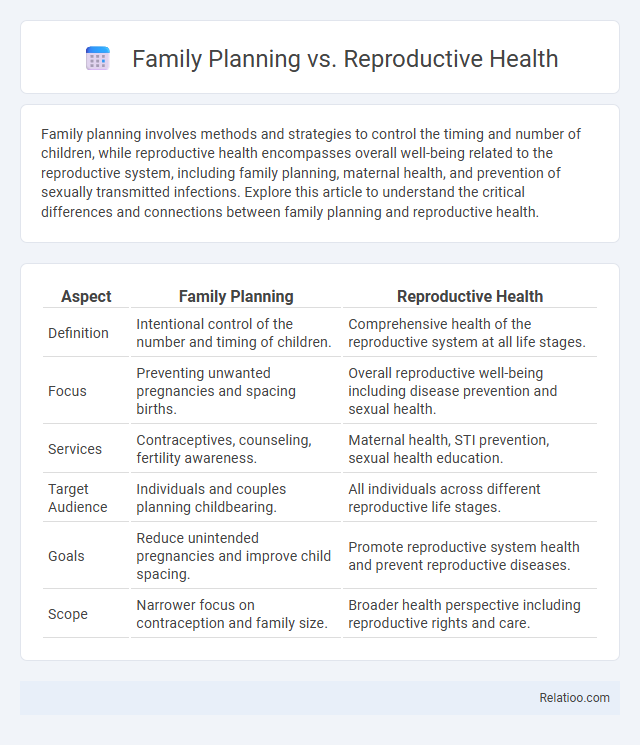Family planning involves methods and strategies to control the timing and number of children, while reproductive health encompasses overall well-being related to the reproductive system, including family planning, maternal health, and prevention of sexually transmitted infections. Explore this article to understand the critical differences and connections between family planning and reproductive health.
Table of Comparison
| Aspect | Family Planning | Reproductive Health |
|---|---|---|
| Definition | Intentional control of the number and timing of children. | Comprehensive health of the reproductive system at all life stages. |
| Focus | Preventing unwanted pregnancies and spacing births. | Overall reproductive well-being including disease prevention and sexual health. |
| Services | Contraceptives, counseling, fertility awareness. | Maternal health, STI prevention, sexual health education. |
| Target Audience | Individuals and couples planning childbearing. | All individuals across different reproductive life stages. |
| Goals | Reduce unintended pregnancies and improve child spacing. | Promote reproductive system health and prevent reproductive diseases. |
| Scope | Narrower focus on contraception and family size. | Broader health perspective including reproductive rights and care. |
Understanding Family Planning: Definition and Scope
Family planning refers to the practice of controlling the number and timing of children through the use of contraceptive methods and education. It encompasses a wide range of services, including contraception, fertility planning, and counseling, aimed at helping individuals and couples achieve their desired reproductive goals. Reproductive health covers a broader spectrum, addressing overall well-being in reproductive processes, while family planning specifically targets contraceptive choices and pregnancy prevention.
Defining Reproductive Health: Broader Implications
Reproductive health encompasses overall well-being related to the reproductive system, including physical, mental, and social aspects beyond just family planning. Your reproductive health involves access to comprehensive services like contraception, prenatal care, sexually transmitted infection prevention, and education on fertility management. Understanding reproductive health's broader implications helps ensure a holistic approach to personal and public health, supporting informed decisions and improved quality of life.
Key Differences Between Family Planning and Reproductive Health
Family planning primarily focuses on the use of contraceptive methods to control the timing and number of children, while reproductive health encompasses a broader scope including sexual health, maternal health, and prevention of sexually transmitted infections. Family planning is a subset within reproductive health, addressing fertility regulation, whereas reproductive health covers overall well-being, safe pregnancy, and access to healthcare services. Key differences include the specific emphasis on contraception in family planning versus the comprehensive approach to reproductive system functioning and health in reproductive health.
Overlapping Goals: Where Family Planning Meets Reproductive Health
Family planning and reproductive health share overlapping goals such as ensuring access to contraceptive methods, promoting maternal health, and preventing unintended pregnancies. Both prioritize education on sexual health, enabling informed decisions and improving overall well-being. Integrating family planning within reproductive health services enhances comprehensive care, supporting safer childbirth and reducing reproductive health risks.
Importance of Education in Family Planning
Education plays a critical role in family planning by empowering individuals with knowledge about contraceptive methods, reproductive rights, and healthy child spacing to improve overall reproductive health outcomes. Comprehensive education increases access to accurate information, enabling informed decisions that reduce unintended pregnancies and promote maternal and child well-being. Integrating family planning education within reproductive health programs enhances community awareness, supports gender equality, and fosters sustainable population growth management.
Comprehensive Care in Reproductive Health Programs
Comprehensive care in reproductive health programs integrates family planning services with broader reproductive health needs, including prenatal care, STI prevention, and fertility treatments. This holistic approach ensures individuals receive tailored counseling and access to a range of contraceptive methods alongside education on sexual health and maternal wellness. Prioritizing comprehensive care improves outcomes by addressing the interconnected aspects of reproductive health and empowering informed decision-making.
Accessibility and Barriers: Services for Diverse Communities
Accessibility to family planning and reproductive health services varies widely among diverse communities due to socioeconomic, cultural, and geographic barriers. Your ability to access comprehensive care depends on factors such as availability of local clinics, affordability, and culturally sensitive providers who understand specific community needs. Overcoming these barriers requires targeted policies that ensure inclusive, affordable, and accessible services for all populations.
Policy and Funding: Supporting Family Planning and Reproductive Health
Effective policy and funding are crucial in supporting family planning and reproductive health services, ensuring accessibility and quality care for diverse populations. Investments prioritize comprehensive education, contraceptive availability, and maternal health programs to reduce unintended pregnancies and improve health outcomes. You benefit from sustained government and NGO commitments that align resources with evidence-based policies promoting equitable reproductive rights and family planning options.
Cultural Perspectives Shaping Choices and Services
Cultural perspectives play a crucial role in shaping choices and services related to family planning and reproductive health, influencing attitudes, access, and acceptance within communities. Your decisions around family planning are often guided by cultural values, religious beliefs, and social norms that impact the availability and type of reproductive health services offered. Understanding these cultural contexts helps tailor effective, respectful, and inclusive family planning programs that meet diverse needs.
Future Trends: Innovations in Family Planning and Reproductive Health
Innovations in family planning and reproductive health increasingly leverage digital health technologies such as mobile apps and telemedicine to enhance accessibility and personalized care. Emerging contraceptive methods, including long-acting reversible contraceptives and male contraceptives, show promise in expanding options and improving effectiveness for diverse populations. Your ability to access tailored reproductive health solutions will benefit from these advancements, shaping future trends toward more inclusive and technology-driven family planning services.

Infographic: Family Planning vs Reproductive Health
 relatioo.com
relatioo.com